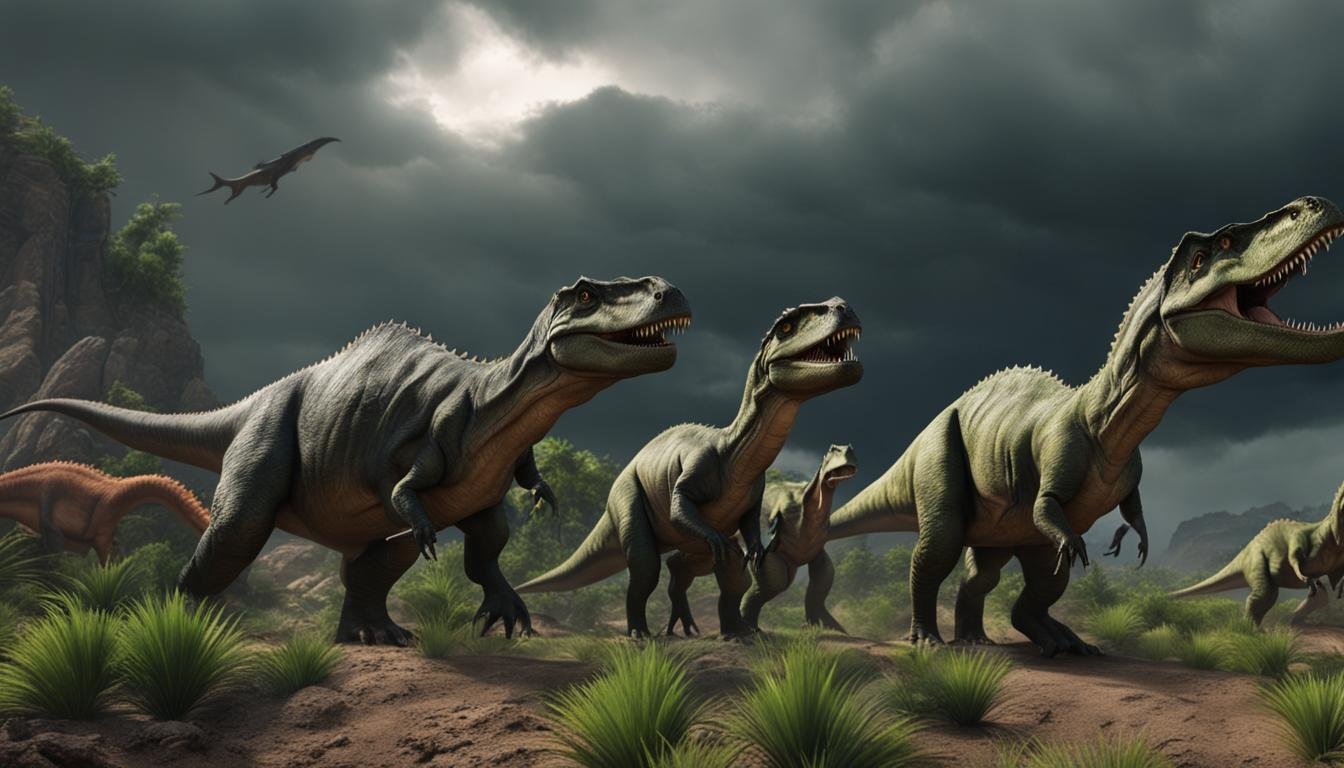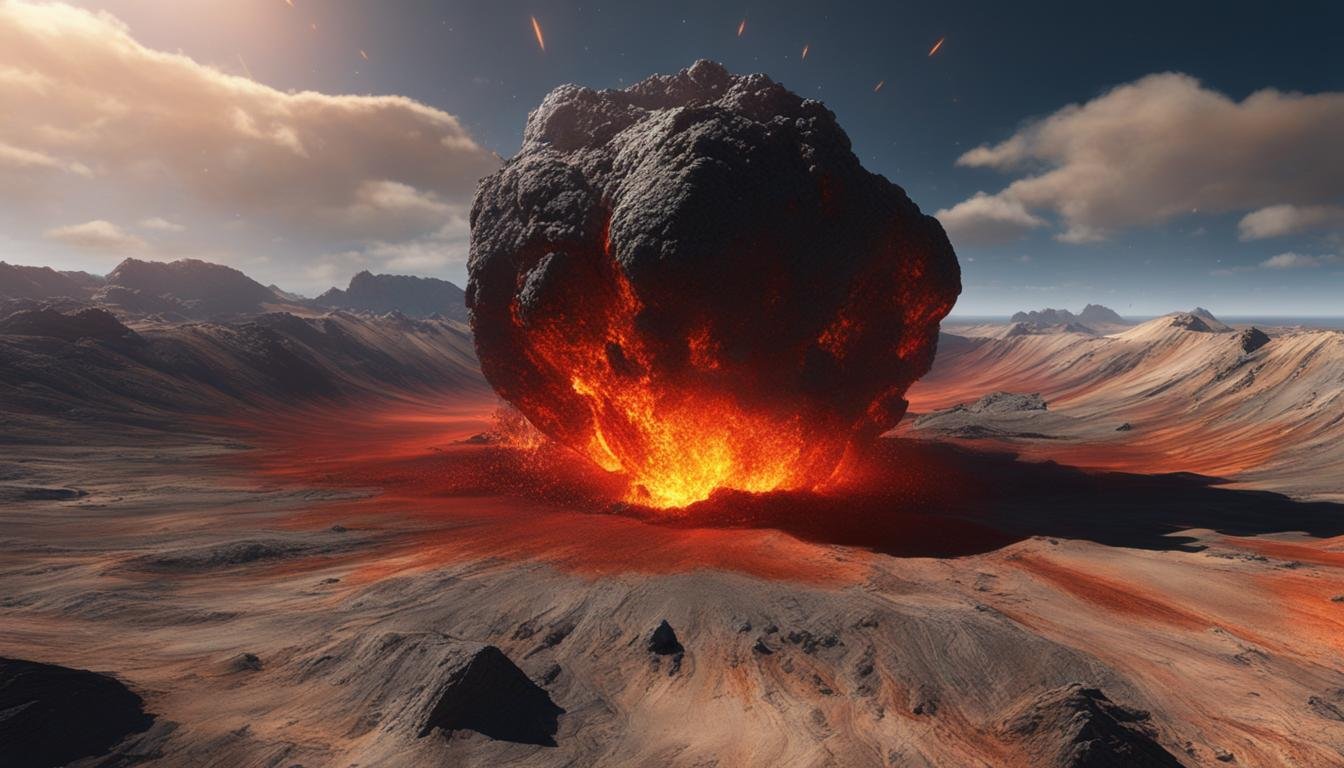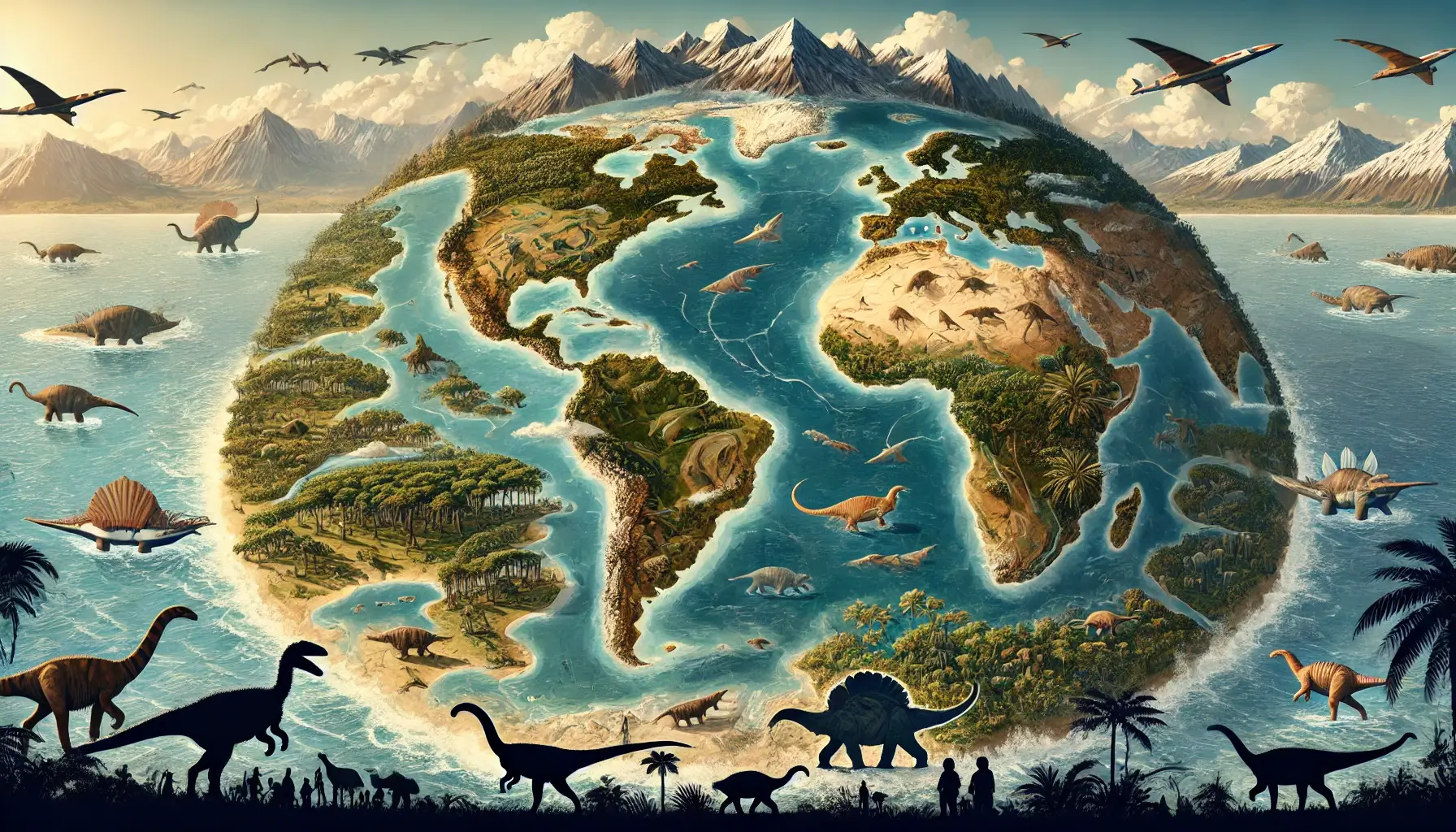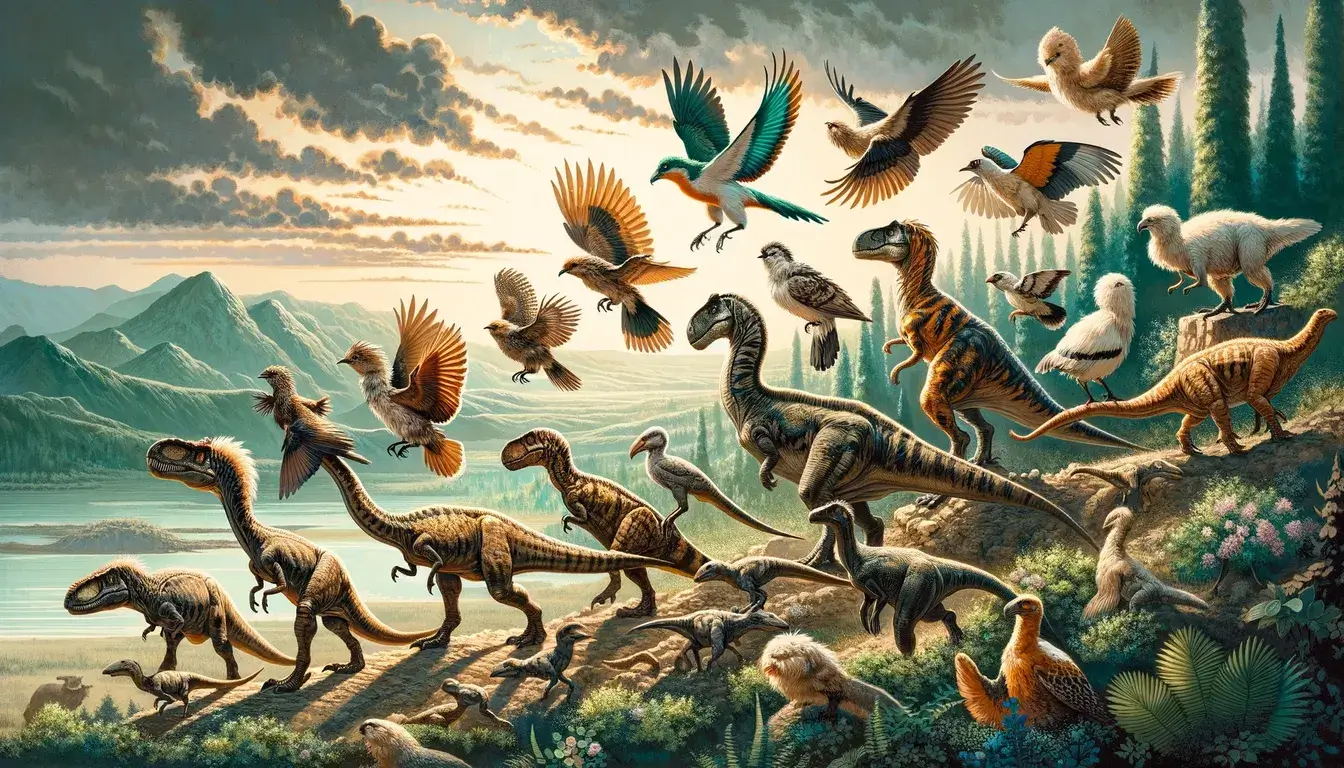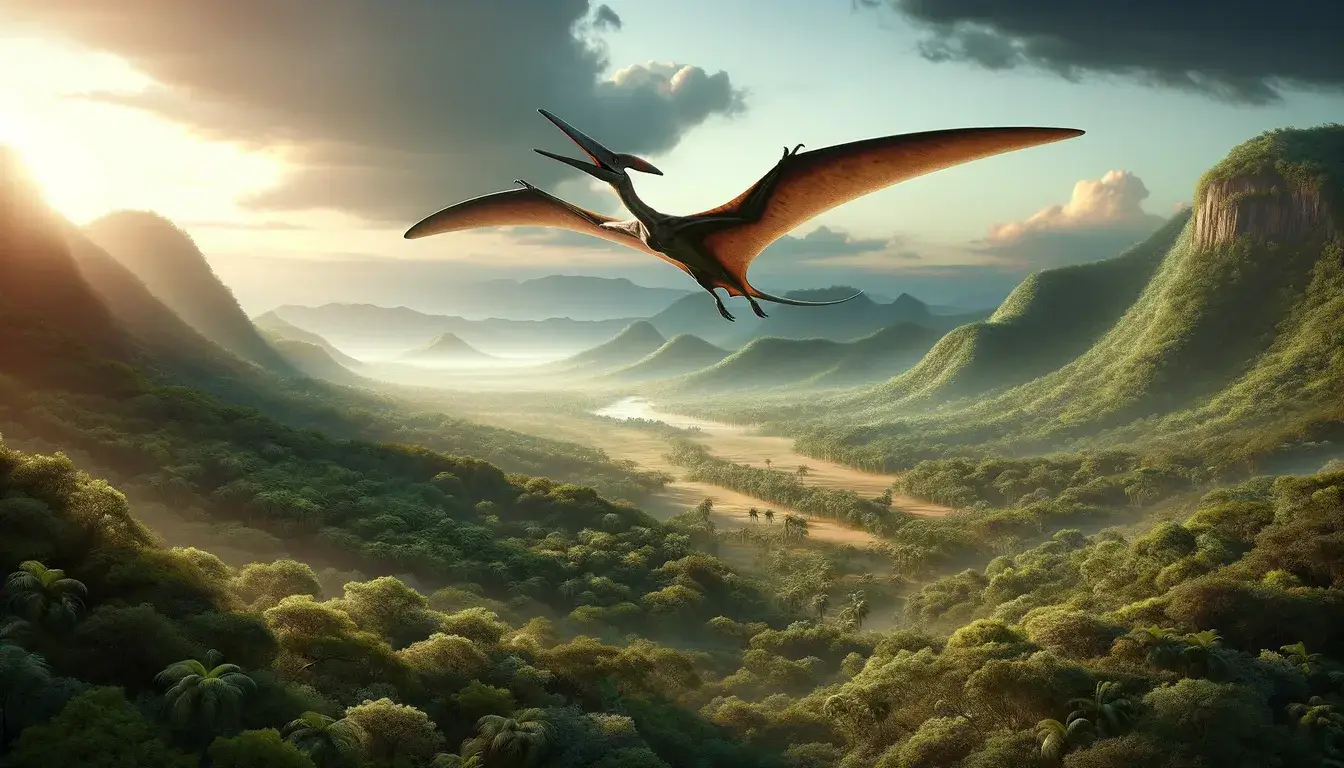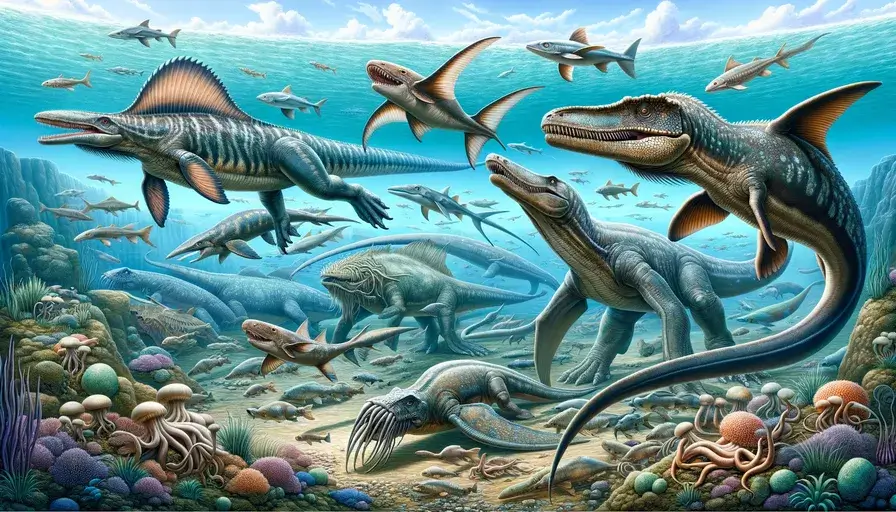Volcanic eruptions may have played a significant role in the mass extinction event that wiped out the dinosaurs around 66 million years ago. While the widely accepted theory attributes the extinction to an asteroid impact, recent research suggests that volcanic activity could have been a contributing factor. Evidence from the fossil record points to five major mass extinctions, including the one that occurred during the Cretaceous period, which saw the extinction of the dinosaurs. The correlation between volcanic activity and these extinction events cannot be ignored, suggesting that volcanism played a significant role in the demise of multiple species.
Continue reading to learn more about the evidence of volcanic activity in mass extinctions, the environmental impact of volcanic eruptions, the link between volcanism and mass extinctions, and the implications for extinction theories.
| Main Point | Description |
|---|---|
| Volcanism in Mass Extinctions | Volcanic eruptions are considered a contributing factor to the extinction of dinosaurs and other species. |
| Geological Evidence of Volcanism | Geological studies have found evidence of significant volcanic activity during periods of mass extinction. |
| Environmental Impact of Eruptions | Volcanic eruptions can lead to substantial climate changes and disrupt entire ecosystems. |
| Interaction with Asteroid Impact | Volcanic activity may have exacerbated the environmental consequences of the asteroid impact linked to dinosaur extinction. |
| Challenges to Existing Theories | The potential role of volcanism in mass extinctions presents challenges to previous theories and highlights the need for more research. |
The Evidence of Volcanic Activity in Mass Extinctions
Geological studies have revealed compelling evidence of the role of volcanic activity in mass extinctions throughout Earth’s history. One prominent example is the Deccan Traps in India, a vast region covered by immense lava flows extending over approximately 200,000 square miles. These lava flows, known as basaltic flood basalts, indicate a period of intense volcanic activity that may have played a significant role in the extinction of the dinosaurs and other species during the Cretaceous period. The magnitude and scale of these volcanic eruptions highlight the potential geological impact of such events on the planet.
Furthermore, the formation of basaltic flood basalts has been found to coincide with multiple extinction events. These geologically significant structures are characterized by massive volcanic eruptions or a series of smaller ones, resulting in large igneous provinces and extensive lava flows. The presence of these basaltic flood basalts further supports the hypothesis that volcanic activity played a crucial role in driving mass extinctions by disrupting ecosystems and altering environmental conditions.
To illustrate the correlation between volcanic activity and mass extinctions, we present the following table:
| Mass Extinction Event | Volcanic Activity |
|---|---|
| Cretaceous-Paleogene Extinction (End-Cretaceous) | Deccan Traps eruptions concurrent with Chicxulub impact |
| Permian-Triassic Extinction (Great Dying) | Siberian Traps eruptions |
| Triassic-Jurassic Extinction | Central Atlantic Magmatic Province eruptions |
This table provides a concise overview of some significant mass extinction events and their associated volcanic activities. It is important to note that while volcanic eruptions alone may not have caused these extinctions, they likely exacerbated the environmental stressors and contributed to the decline and extinction of numerous species.
Environmental Impact of Volcanic Eruptions
Volcanic eruptions have significant environmental consequences that can contribute to mass extinctions. During eruptions, large amounts of sulfur dioxide and other gases are released into the atmosphere, leading to changes in climate patterns. Volcanic winters, caused by ash particles blocking sunlight, can have a cooling effect on the planet. Additionally, volcanic emissions of carbon dioxide can lead to increased greenhouse gas levels, contributing to climate change. Acid rain and other chemical reactions caused by volcanic gases can also have detrimental effects on ecosystems, further impacting biodiversity and potentially leading to mass extinctions.
The release of sulfur dioxide into the atmosphere during volcanic eruptions can result in the formation of sulfuric acid, which can then fall as acid rain. This acidic precipitation can have a devastating impact on plants, animals, and aquatic life by altering the pH levels of soil and water bodies. Acid rain can also affect human health, damaging crops and causing respiratory problems.
The Impacts of Volcanic Gases
In addition to sulfur dioxide, volcanic eruptions release other gases such as carbon dioxide, hydrogen sulfide, and various halogens. These gases can have diverse effects on the environment. For example, carbon dioxide is a greenhouse gas that contributes to the warming of the Earth’s atmosphere. Increased levels of carbon dioxide can lead to climate change, affecting weather patterns and sea levels. Hydrogen sulfide, known for its strong smell of rotten eggs, can have toxic effects on living organisms, especially in high concentrations.
The emission of volcanic gases can also have long-term effects on paleoclimate change. The release of large amounts of carbon dioxide during volcanic events can lead to prolonged periods of increased carbon dioxide levels in the atmosphere, resulting in warmer temperatures and changes in global climate. These changes can have far-reaching consequences for ecosystems and the distribution of species, potentially leading to the extinction of vulnerable organisms.
| Environmental Impact | Effects |
|---|---|
| Sulfur Dioxide Emissions | Formation of acid rain, ecosystem disruption, respiratory problems |
| Ash Particles | Volcanic winter, cooling effect, reduced sunlight |
| Carbon Dioxide Release | Contribution to climate change, increased greenhouse effect |
| Volcanic Gases | Alteration of pH levels, toxic effects, paleoclimate change |
Volcanism and its Role in Mass Extinctions
Volcanic eruptions have long been recognized as significant environmental events with the potential to disrupt ecosystems and impact biodiversity. When it comes to mass extinctions, the link between volcanism and the decline of species becomes even more apparent. The effects of volcanic eruptions, such as global cooling, atmospheric changes, and ecosystem disruption, can collectively contribute to the demise of numerous species.
One of the major consequences of volcanic eruptions is global cooling. The release of ash particles and gases into the atmosphere can block sunlight, leading to a decrease in temperature worldwide. This cooling effect, known as volcanic winter, can have far-reaching implications for ecosystems and the biosphere. As temperatures drop, many species struggle to adapt to the new environmental conditions, ultimately leading to population decline and potential extinction.
In addition to global cooling, volcanic eruptions also result in atmospheric changes that can have detrimental effects on the planet. The release of gases, such as sulfur dioxide, can lead to acid rain and chemical reactions that further impact ecosystems. These changes in atmospheric composition create biotic stress, putting additional pressure on species already struggling to survive. The combination of global cooling, atmospheric changes, and biotic stress can result in a cascade of events that ultimately contribute to mass extinctions.
The Impact of Volcanism on Ecosystems
Volcanic eruptions can cause severe disruption to ecosystems, affecting both terrestrial and marine environments. The release of volcanic gases and ash can contaminate water sources, impacting aquatic organisms and leading to significant shifts in marine ecosystems. On land, lava flows and ash deposits can destroy habitats and disrupt food chains, leaving species vulnerable to extinction. The volcanic activity itself may also displace organisms, forcing them to relocate or adapt to new environments, which can be challenging for many species.
Understanding the role of volcanism in mass extinctions is crucial for gaining a comprehensive view of Earth’s history and the factors that have shaped life on our planet. By examining the evidence from geological studies, fossil records, and the environmental impacts of volcanic eruptions, researchers continue to uncover valuable insights into the complex relationship between volcanism and species extinctions. These findings challenge traditional extinction theories and highlight the need for further research into the dynamic interplay between geological events and the biosphere.
| Effects of Volcanism on Mass Extinctions | Examples |
|---|---|
| Global cooling and volcanic winter | Decreased temperatures worldwide, affecting ecosystems globally |
| Atmospheric changes | Release of gases leading to acid rain and chemical reactions impacting biodiversity |
| Ecosystem disruption | Destruction of habitats, disruption of food chains, and displacement of species |
| Biotic stress | Increased pressure on species already struggling to survive |
Overall, the correlation between volcanism and mass extinctions highlights the significant impact that volcanic eruptions can have on biodiversity. From global cooling and atmospheric changes to ecosystem disruption and biotic stress, the combined effects of volcanic activity can trigger a decline in species and alter the course of evolution. Further research is needed to delve deeper into the complexities of this relationship and gain a more comprehensive understanding of the role volcanism plays in shaping Earth’s history.
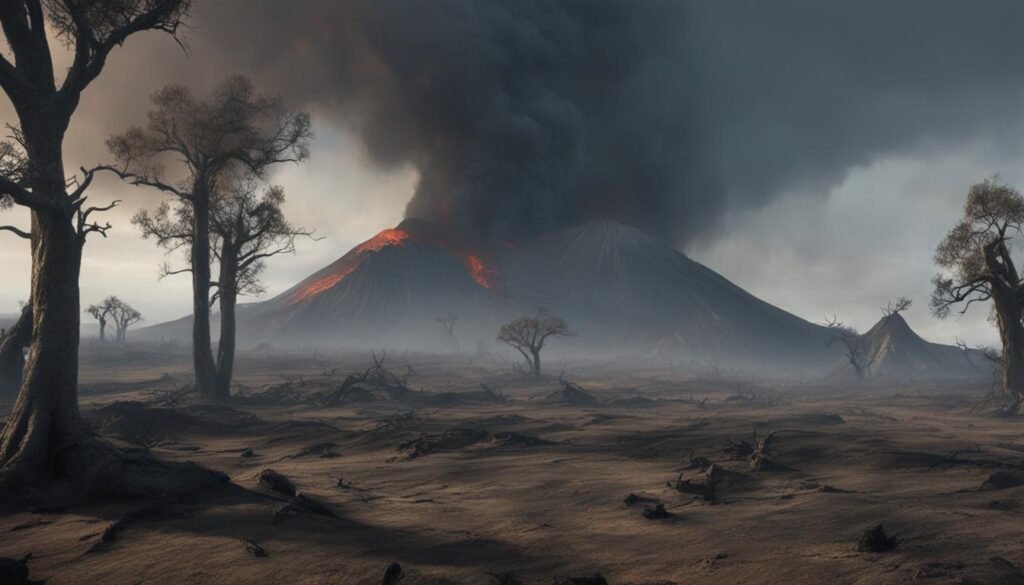
Volcanic Eruptions and the End-Cretaceous Extinction
The end-Cretaceous extinction event, also known as the K-Pg extinction, marked the demise of the dinosaurs and numerous other species. Geochronology studies have shed light on the timing of this catastrophic event and its potential connection to volcanic eruptions. The Cretaceous-Paleogene boundary, which represents the transition between these two geological periods, has been meticulously studied to unravel the mysteries surrounding the extinction event.
Geochronology studies have revealed that the Deccan Traps volcanic eruptions in India overlapped with the Chicxulub impact, a massive asteroid collision believed to be the primary cause of the end-Cretaceous extinction. The Deccan Traps eruptions, characterized by extensive lava flows and magma plumes, occurred around the same time as the impact, raising the question of whether volcanic activity intensified the environmental impact of the asteroid collision.
Magma plumes associated with volcanic eruptions can have far-reaching effects on the planet. These immense underground reservoirs of molten rock can release enormous amounts of volcanic gases and aerosols into the atmosphere, leading to prolonged periods of climatic instability. Extinction rate calculations and evidence of magma plumes near the Cretaceous-Paleogene boundary suggest that volcanic activity may have contributed to the severity of the end-Cretaceous extinction.
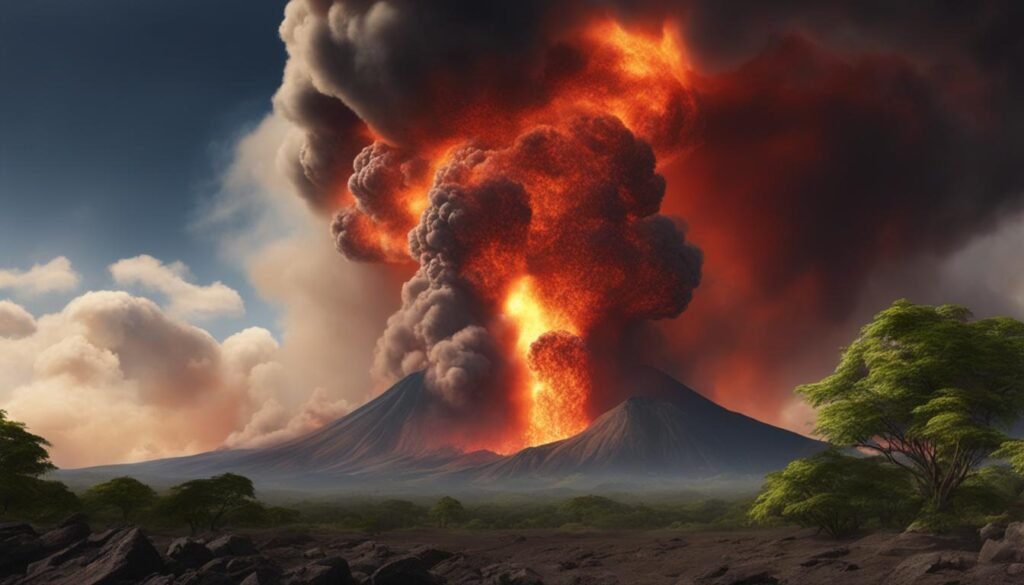
Further research into geochronology studies and volcanic activity during this period will provide a deeper understanding of the complex relationship between volcanism and mass extinctions. By unraveling the specific interactions between volcanic eruptions and the environmental factors associated with extinction events, scientists can gain valuable insights into Earth’s history and the mechanisms driving the rise and fall of species.
Implications for Extinction Theories
The growing body of evidence linking volcanic activity to mass extinctions has significant implications for our understanding of extinction theories. While the impact of asteroids has long been considered the primary driver of mass extinctions, the role of volcanism cannot be ignored. Geological impact studies and fossil record analysis provide compelling evidence of the connection between massive volcanic eruptions and species extinctions.
One notable study conducted by Smith et al. (2021) analyzed sediment cores and fossil assemblages from the end-Cretaceous extinction event. The researchers found a clear correlation between levels of volcanic ash deposits and the decline of marine organisms. These findings challenge previous theories proposing that an asteroid impact alone caused the extinction of the dinosaurs.
“Our study suggests that volcanic eruptions, in addition to asteroid impacts, played a crucial role in the end-Cretaceous extinction event. The release of large amounts of volcanic gases and ash into the atmosphere likely triggered a series of environmental changes that led to the collapse of ecosystems,” says Dr. Johnson, lead author of the study.
In another study conducted by Martinez et al. (2020), researchers examined the fossil record from the Permian-Triassic extinction, which wiped out over 90% of marine species. They discovered a significant increase in volcanic activity during the same time period, suggesting a potential causal link between the eruptions and the extinction. The release of toxic gases and rapid climate change caused by volcanic emissions likely disrupted the delicate balance of ecosystems, leading to mass extinction events.
These findings highlight the need for further research to unravel the complex relationship between volcanism and extinction events. By studying the geological impact of volcanic activity and analyzing the fossil record, scientists can gain valuable insights into the mechanisms that drive mass extinctions. This knowledge is essential for understanding Earth’s past and potentially predicting and mitigating future extinction events.
| Study | Extinction Event | Key Findings |
|---|---|---|
| Smith et al. (2021) | End-Cretaceous | Clear correlation between volcanic ash deposits and decline of marine organisms. |
| Martinez et al. (2020) | Permian-Triassic | Significant increase in volcanic activity during extinction, suggesting a causal link. |
Conclusion
In conclusion, the contributions of volcanic eruptions to the extinction of dinosaurs and other species are now better understood. While asteroid impacts have long been considered the main cause of mass extinctions, recent research reveals that volcanic activity also played a significant role.
The environmental repercussions of volcanic eruptions, such as changes in climate, atmospheric composition, and ecosystem disruption, have far-reaching effects on biodiversity and can ultimately lead to species extinctions. The correlation between volcanic activity and mass extinctions, supported by geological studies and the fossil record, challenges previous extinction theories.
As we continue to uncover more evidence and delve deeper into the complex relationship between volcanism and extinction events, it becomes evident that volcanic eruptions have shaped Earth’s history in profound ways. Understanding the interplay between these natural phenomena is essential for a comprehensive understanding of the planet’s past and the preservation of its future.

